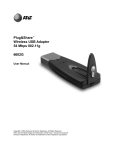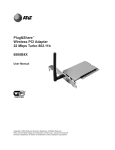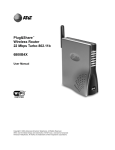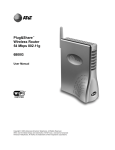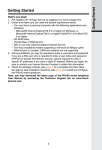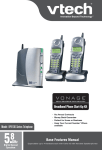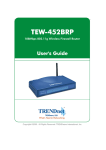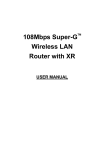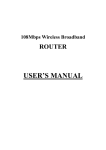Download AT&T Plug&Share 6750G User manual
Transcript
Plug&Share™ Wireless Notebook Adapter 802.11g / 108 Mbps 6750G User Manual Copyright © 2004 Advanced American Telephones. All Rights Reserved. AT&T and the Globe Design are trademarks of AT&T Corp., licensed to Advanced American Telephones. All marks are trademarks of their respective corporations. Table of Contents Table of Contents INTRODUCTION..........................................................................3 Overview ........................................................................3 Package contents............................................................3 System requirements ......................................................3 DRIVER & ADAPTER INSTALLATION ......................................4 Step 1: Install driver & configuration utility......................4 Step 2: Install wireless adapter ......................................4 Step 3: Recognize the hardware ....................................4 CONFIGURE ADAPTER FOR YOUR NETWORK ....................5 Installation Wizard ..........................................................5 Test Internet access ........................................................6 Link Info screen ..............................................................7 Configuration screen ......................................................8 Security screen ..............................................................9 Site Survey screen ........................................................11 ENABLE FILE AND PRINTER SHARING ................................11 File & print sharing for Windows® XP............................12 File & print sharing for Windows® 2000 ........................19 File & print sharing for Windows® Me and 98 SE ........25 TROUBLESHOOTING ..............................................................31 GLOSSARY ..............................................................................33 TECHNICAL SPECIFICATIONS ..............................................38 CARE AND MAINTENANCE ....................................................38 Before you begin • If you have a Windows® XP or Windows® 2000 operating system, and you are installing this adapter on a PC you use at work, you must have “Administrator Rights”. This is normally determined by your IT person at work. • If you have used an earlier AT&T 802.11b Series adapter (or one by another manufacturer), you must uninstall all drivers and utilities before installing your new adapter. If your system has a built-in wireless adapter, you must disable it before installing your new adapter. AT&T Plug&Share™ Wireless Notebook Adapter 108 Mbps 6750G 2 Introduction Overview The AT&T Plug&Share™ Wireless Notebook Adapter will allow you to connect a notebook computer with an available Type II PCMCIA slot to a compatible wireless network. Package Contents Please check to make sure your package contains the following items: Quick Start Guide Plug&Share™ Wireless Notebook Adapter 108 Mbps 802.11g CD-ROM Contains installation software and printable versions of this User Manual, Quick Start Guide and Safety & Warranty Information. Safety & Warranty Information System Requirements: You must have a notebook computer with the following applications & hardware: • Windows® 98 SE, Me, 2000 or XP • Type II PCMCIA card slot • Intel® Pentium II (or higher) • 64 MB of RAM • CD-ROM drive • 5 MB of available hard-disk space (60 MB to load Adobe® Acrobat® Reader®) • AT&T Plug&Share™ Wireless Router (or other 802.11b or g compliant router or access point) • AT&T Plug&Share™ Wireless 6850G Router (for 108 Mbps data rate) AT&T Plug&Share™ Wireless Notebook Adapter 108 Mbps 6750G 3 Installation STEP 1: Install the Driver and Configuration Utility 1 Do NOT install adapter first. Insert the enclosed CD-ROM into your CD-ROM drive. 2 Your CD auto-run function may start automatically. If it does not, click on the Start button. Click Run and enter D:\autorun. (If your CD-ROM drive is not your D drive, use the appropriate drive letter.) 3 When the adapter menu screen appears, click on Install Software from the menu on the left side of the screen. 4 The InstallShield Wizard will appear. 5 Different versions of Windows® will present different screens. Press Next at each screen until the Wizard driver installation has completed. IMPORTANT: Remove CD-ROM disk before continuing. 6 Some versions will present a screen that asks about restarting your computer. Choose Yes, I will restart my computer now. 7 Click Finish, if necessary. A new icon will appear on your Windows® desktop. You can double-click it to launch the utility at any time. Proceed to Step 2 only after the software has been correctly installed. If correctly installed, a Utility icon (four vertical bars) should appear next to your computer’s time display. An “X” indicates that software installation was successful, but the wireless adapter is not yet activated. STEP 2: Insert the Notebook Adapter With the card label up, insert the card into the notebook computer PCMCIA slot. STEP 3: Recognize the Hardware Depending on the Windows® operating system version running on your computer, one of several screens may appear to inform you that the computer recognizes new hardware. Choose to install the software automatically and click Next. Depending on your Windows® version, you may see a Hardware Alert message or a Digital Signature Not Found message. Click Continue Anyway or Yes to complete the installation. Depending on your Windows® version, you may have to restart your computer to complete the installation. If a Windows® message prompts you to restart your computer, do so. Finally, some versions may display the message Systems Settings Change. Click Yes. Check the indicator lights to verify that the adapter is working: • Act/Link: After the notebook adapter is inserted, the Act/Link lights will blink when there is traffic flow on the network. AT&T Plug&Share™ Wireless Notebook Adapter 108 Mbps 6750G 4 Adapter Configuration Wizard • Link Info. • Configuration • Security • Site Survey • About STEP 4: Configure the Notebook adapter for your wireless network Check the Utility icon (four vertical bars) next to your computer’s time display. If the bars are green, you are already connected and do not need to run the Wizard (skip to bottom of page 6). If the bars are not green within 30 seconds, double-click the Utility icon, then click the Run Wizard button at the next screen. Double-click here to launch Utility (see below). Number of green bars shows signal strength. Click to begin. Wizard screen 1 SSID Enter the SSID (Service Set Identifier) used by your wireless router or access point. The default SSID is at&t. The SSID is case sensitive (i.e., “cat” and “Cat” are not the same). All wireless adapters on your network must use the same SSID as your wireless router and/or access point. WEP Encryption WEP is a form of encryption. If you click On to enable encryption in your wireless adapter, you must turn on WEP in your router, and make sure all devices use the same settings. Click Apply to save your settings and display Wizard screen 2 (see next page). NOTE: The Wizard screen (above) always shows factory default settings, even if you have changed them. Go to the Configuration screen to see your customized settings. CAUTION: SSID and all WEP settings must be identical in all wireless network devices. WEP Ascii/Hex Key must match the WEP settings used in your router (may be called Security Phrase, Hex Key or other term). AT&T Plug&Share™ Wireless Notebook Adapter 108 Mbps 6750G 5 Adapter Configuration Wizard • Link Info. • Configuration • Security • Site Survey • About Wizard screen 2 This screen shows the status of your network connection. Your adapter should have found the network associated with the SSID you entered, and automatically set the channel to agree with your wireless router and/or access point. If you see Pass in the top two fields on this screen, you are ready to close this window and begin using your wireless network. Test this by visiting the Internet (see below). You can view or change the adapter setting from the other screens. Just click on the tabs in the blue menu bar at the top of this screen. Test Internet Access To test Internet access, launch your web browser and enter: www.plugandshare.att.com When you press Enter, the AT&T Plug&Share™ screen should appear. If it does not, see the Troubleshooting section on page 31. Problems? If this screen does not appear when you test Internet access, or if you see the word Fail in either of the top two fields of the Wizard screen shown above, please turn to the Troubleshooting section on page 31. AT&T Plug&Share™ Wireless Notebook Adapter 108 Mbps 6750G 6 Adapter Configuration Wizard • Link Info. • Configuration • Security • Site Survey • About Link Info This screen displays current settings. (To change any of these settings, click Configuration at the top of the screen.) Status: The MAC address of the router, or access point, associated with the wireless adapter. SSID: The Service Set Identifier of the network. This is the setting given to the access point, or router. TX Rate: The current transmission speed setting. Channel: The current channel setting of the wireless network. Rescan: Refresh the text fields. Link Quality/Signal Strength/Data Rate: The lower part of the screen displays the current quality of the network link, strength of the signal, and the current transmit and receive rates. AT&T Plug&Share™ Wireless Notebook Adapter 108 Mbps 6750G 7 Adapter Configuration Wizard • Link Info. • Configuration • Security • Site Survey • About Configuration The Configuration screen displays the current settings of the wireless adapter. SSID: Enter the SSID used by your wireless router or access point. All wireless adapters on your network must use the same SSID as your wireless router and/or access point. The SSID is case sensitive (i.e., “cat” and “Cat” are not the same). BSS Type: The BSS type may be set to Infrastructure (connected to the WLAN using an Access Point) or Ad-Hoc (connected in a peer-to-peer environment). AdHoc Band: It is usually not necessary to change this setting. This feature is required only if you have a peer-to-peer wired connection between computers. Channel: The router uses radio signals to communicate with other devices on the network. You can change the frequency by selecting a different channel. Remember that all computers on your network must use the same channel. Devices using AT&T Plug&Share™ wireless adapters will automatically detect the channel used by the router and change to it. You may have to change the channel if you are experiencing problems such as intermittent connection and disconnection. You can perform a site survey on your wireless adapter to find out which channels are being used by other wireless networks nearby. If other networks use the same channel (or an adjacent one), change yours to one as far away as possible from the others in use. (For example, if other networks use channels 6, 9 and 11, try changing yours to channel 1.) TX Rate: If you use an AT&T Plug&Share™ router, set the TX (transmission) rate to Auto. If you are not using an AT&T Plug&Share™ router, set the TX rate to the fastest speed your router or access point can support. The default setting (Auto) will continually test to find and use the highest transmission speed possible, but this setting may cause data errors. If you experience this problem, try a lower rate. Preamble: The Preamble Type refers to the radio preamble, or header, which is transmitted at the beginning of a packet of data.You should not change this setting unless directed to do so by a network administrator. Power Mode: Select Continuous Access Mode (default) for fewer communication errors, although this setting consumes more power than the others. Maximum Power Save consumes the least power, and Power Save consumes a diminished amount of power. Auto Searching: This option allows your wireless adapter to automatically search for available wireless routers or access points nearby. When enabled, your computer will connect to whichever router or access point that has the strongest signal. If you change any setting above, click the Apply button. AT&T Plug&Share™ Wireless Notebook Adapter 108 Mbps 6750G 8 Adapter Configuration Wizard • Link Info. • Configuration • Security • Site Survey • About Security The Security screen allows you to set the privacy settings of your wireless PCI adapter. All settings must match the settings of your wireless router or access point. Click the drop-down menu to select a security option: Disable: No security. Not recommended. WEP: Moderate security (see below). WPA: Suitable only for large enterprise networks (see page 10). WPA-PSK: High security for home, home-office & small business (see page 10). NOTE: If you want to enable security, you should choose WPA-PSK for the highest level of security protection. WEP Security (Wired Equivalent Privacy): Select this option for a moderate level of security. Phrase/Key: Enter a security phrase. If you choose the Hex Key Format (see below), you must use hexadecimal digits (0-9, a-f). If you choose the ASCII Key Format you can use letters, numbers, spaces, and punctuation marks. For the ASCII Key Format you must enter five characters for 64-bit, 13 characters for 128-bit or 16 characters for 152-bit encryption. Whichever format you use, the security phrase you enter must match the one set for your wireless router or access point. You can create up to four different security phrases, for different wireless networks. Remember that security phrases are case sensitive (i.e., “cat” and “Cat” are not the same). Key Format: Choose ASCII or hexadecimal format. If you choose ASCII, you can use names that you know and can easily remember for your key. Length: Use the drop-down menu to choose a key length. The higher the number, the slower and more secure your system is. If you change any setting above, click the Apply button. AT&T Plug&Share™ Wireless Notebook Adapter 108 Mbps 6750G 9 Adapter Configuration Wizard • Link Info. • Configuration • Security • Site Survey • About WPA Enterprise Security (WiFi Protected Access): Select this option only if you are using your adapter in a large enterprise network environment such as a company or school. Consult your network administrator for advice before selecting this option. WPA Personal Security (WiFi Protected Access, Preshared Key): Select this option for the highest level of security protection in a home, home office or small business environment. Passphrase: Enter a security phrase at least eight characters long.The phrase you enter must match the one set for your wireless router or access point. Remember that security phrases are case sensitive (i.e., “cat” and “Cat” are not the same). Click the Apply button after entering your passphrase to activate WPAPSK encryption. AT&T Plug&Share™ Wireless Notebook Adapter 108 Mbps 6750G 10 Adapter Configuration Wizard • Link Info. • Configuration • Security • Site Survey • About Site Survey The Site Survey screen shows a list of wireless networks nearby that are available for connection. Select a network and click Connect to establish a connection. Click Refresh to update the list and show additional networks that may have become available since you last checked. The Profile section shows a list of profiles you may have set up for various wireless networks; for example, at home, at work, or in public places such as an airport or internet café. Click Add to create a new profile, Remove to delete a profile, or Properties to configure a profile to connect with an available network. To change network settings Change the wireless notebook adapter settings at any time by double-clicking the Utility icon, (4 vertical bars next to your computer’s time display). Use the tabs in the blue bar at the top of the screen to display the Wizard, Link Info, Configuration, Security, or Site Survey screens. Configuring Windows® for File and Printer Sharing Some configuration of Windows® is necessary to make full use of your wireless network. This will take a few minutes, but it is a one-time process that you will not need to repeat. Please turn to the pages listed for instructions on how to configure your operating system. Windows® XP ............................Pages 12-18 Windows® 2000 ........................Pages 19-24 Windows® Me/98 SE ................Pages 25-30 Caution Before making any changes to your networking settings, please review this section carefully. Failure to follow these instructions precisely may result in the inability to log into your network or computer. If your computer is part of a work environment please contact your IT professional before proceeding. AT&T Plug&Share™ Wireless Notebook Adapter 108 Mbps 6750G 11 Configuring the Wireless Network — Windows® XP Windows® XP • Windows® 2000 • Windows® Me/98 SE Configure Windows® XP for Network Sharing Caution Before making any changes to your networking settings, please review this section carefully. Failure to follow these instructions precisely may result in the inability to log into your network or computer. If your computer is part of a work environment, please contact your IT professional before proceeding. Step 1 Click Start > Control Panel. Step 2 Click Network and Internet Connections. Step 3 Click Network Connections. AT&T Plug&Share™ Wireless Notebook Adapter 108 Mbps 6750G 12 Configuring the Wireless Network — Windows® XP Windows® XP • Windows® 2000 • Windows® Me/98 SE Step 4 Click Wireless Network Connection. Step 5 Click the Properties button. Step 6 Make sure File and Printer Sharing for Microsoft Networks appears in this list, and check it if it is unchecked. If you do not see it in the list, click the Install button and follow directions to install File and Printer Sharing for Microsoft Networks. Click OK when File and Printer Sharing is installed and checked. AT&T Plug&Share™ Wireless Notebook Adapter 108 Mbps 6750G 13 Configuring the Wireless Network — Windows® XP Windows® XP • Windows® 2000 • Windows® Me/98 SE Step 7 Highlight the My Computer icon on your desktop, then click the right mouse button. Scroll down to click on Properties. Step 8 Click the Change button. Step 9 Enter a unique name to identify your computer. Each computer must have a different name. Enter a workgroup name. All computers must use the same workgroup. It may be easiest to use the default name, “Workgroup.” AT&T Plug&Share™ Wireless Notebook Adapter 108 Mbps 6750G 14 Configuring the Wireless Network — Windows® XP Windows® XP • Windows® 2000 • Windows® Me/98 SE Step 10 When configuration is complete, you must restart Windows®. When Windows® restarts you will be prompted to enter a user name and password. Be sure to record these in a safe place. You will be required to enter them for access to the network each time you restart Windows®. Step 11 To verify that configuration is complete, doubleclick the My Computer icon on your desktop, then double-click My Network Places. In the next window displayed you should see the names of all network computers. If any computers do not appear, you will have to follow the steps in this section on each computer to configure them for network sharing. Make sure each computer is assigned a different name, and all share the same Workgroup name you entered at Step 9. AT&T Plug&Share™ Wireless Notebook Adapter 108 Mbps 6750G 15 Configuring the Wireless Network — Windows® XP Windows® XP • Windows® 2000 • Windows® Me/98 SE Configure Windows® XP for Printer Sharing Step 1 Click Start > Printers and Faxes. Step 2 Place the cursor on the printer you want to share, then click the right mouse button. Scroll down to select Sharing. NOTE: If your printer is not listed in this window, double-click Add a Printer, then follow the instructions to set up your printer for use. Step 3 Click the Share this printer button, then enter a unique name for this printer. To continue, click the Additional Drivers button. Step 4 Check boxes for all operating systems that will use this printer. Click OK when finished. AT&T Plug&Share™ Wireless Notebook Adapter 108 Mbps 6750G 16 Configuring the Wireless Network — Windows® XP Windows® XP • Windows® 2000 • Windows® Me/98 SE Configure Windows® XP for File Sharing Step 1 Double-click the My Computer icon on your desktop. Step 2 Place the cursor on the disk drive you want to share (usually Drive C:), then click the right mouse button and scroll down to select Sharing and Security. NOTE: This will allow others access to all files on this computer. To restrict access to certain folders, doubleclick on the disk, highlight a folder you want to share, then follow steps 2-3. Step 3 Check the Share this folder on the Network box, then enter a unique name for the drive or folder you want to share. NOTE: To protect your files with higher levels of security, please refer to instructions provided with your Windows® operating system. Click OK when finished. AT&T Plug&Share™ Wireless Notebook Adapter 108 Mbps 6750G 17 Configuring the Wireless Network — Windows® XP Windows® XP • Windows® 2000 • Windows® Me/98 SE To Share Network Files in Windows® XP Step 1 Double-click the My Network Places icon on your desktop. Step 2 Double-click View Workgroup Computers to see a list of all computers connected to your network. Step 3 Double-click any icon to see a list of all shared folders on that computer. Step 4 Double-click any folder for access to any file in that folder. AT&T Plug&Share™ Wireless Notebook Adapter 108 Mbps 6750G 18 Configuring the Wireless Network — Windows® 2000 Windows® XP • Windows® 2000 • Windows® Me/98 SE Configure Windows® 2000 for Network Sharing Caution Before making any changes to your networking settings, please review this section carefully. Failure to follow these instructions precisely may result in the inability to log into your network or computer. If your computer is part of a work environment, please contact your IT professional before proceeding. Step 1 Click Start > Settings > Network and Dial-up Connections. Step 2 Double-click Local Area Connections. Step 3 Click the Properties button. Step 4 Make sure File and Printer Sharing for Microsoft Networks appears in this list, and check it if it is unchecked. If you do not see it in the list, click the Install button and follow directions to install File and Printer Sharing for Microsoft Networks. Click OK when File and Printer Sharing is installed and checked. AT&T Plug&Share™ Wireless Notebook Adapter 108 Mbps 6750G 19 Configuring the Wireless Network — Windows® 2000 Windows® XP • Windows® 2000 • Windows® Me/98 SE Step 5 Click Start > Settings > Control Panel. Step 6 Double-click System. Step 7 Click the Properties button. Step 8 Enter a unique name to identify your computer. Each computer must have a different name. Enter a workgroup name. All computers must use the same workgroup. It may be easiest to use the default name, “Workgroup.” AT&T Plug&Share™ Wireless Notebook Adapter 108 Mbps 6750G 20 Configuring the Wireless Network — Windows® 2000 Windows® XP • Windows® 2000 • Windows® Me/98 SE Step 9 When configuration is complete, you must re-start Windows®. When Windows® restarts you will be prompted to enter a user name and password. Be sure to record these in a safe place. You will be required to enter them for access to the network each time you restart Windows®. Step 10 To verify that configuration is complete, doubleclick the My Network Places icon on your desktop, then double-click Computers Near Me. In the next window displayed you should see the names of all network computers. If any computers do not appear, you will have to follow the steps in this section on each computer to configure them for network sharing. Make sure each computer is assigned a different name, and all share the same Workgroup name you entered at Step 8. AT&T Plug&Share™ Wireless Notebook Adapter 108 Mbps 6750G 21 Configuring the Wireless Network — Windows® 2000 Windows® XP • Windows® 2000 • Windows® Me/98 SE Configure Windows® 2000 for Printer Sharing Step 1 Click Start > Settings > Printers. Step 2 Place the cursor on the printer you want to share, then click the right mouse button. Scroll down to select Sharing. NOTE: If your printer is not listed in this window, double-click Add Printer, then follow the instructions to set up your printer for use. Step 3 Click the Shared As button, then enter a unique name for this printer. To continue, click on the Security tab at the top of this window. Step 4 At this screen you can set permissions for each user of the printer. Unless you have special needs for security, it may be easiest to check Allow for all permissions and all user names listed. NOTE: To set more restrictive printer permissions, please refer to instructions provided with your Windows® operating system. Click OK when finished. AT&T Plug&Share™ Wireless Notebook Adapter 108 Mbps 6750G 22 Configuring the Wireless Network — Windows® 2000 Windows® XP • Windows® 2000 • Windows® Me/98 SE Configure Windows® 2000 for File Sharing Step 1 Double-click the My Computer icon on your desktop. Step 2 Place the cursor on the disk drive you want to share (usually Local Drive C:), then click the right mouse button and scroll down to select Sharing. NOTE: This will allow others access to all files on this computer. To restrict access to certain folders, doubleclick on the disk, highlight a folder you want to share, then follow steps 2-4. Step 3 Click the Share this folder button, then enter a unique name for the drive or folder you want to share. To continue, click the Permissions button. Step 4 At this screen you can set permissions for each user of shared documents. Unless you have special needs for security, it may be easiest to check Allow for all permissions. NOTE: To set more restrictive permissions, please refer to instructions provided with your Windows® operating system. Click OK when finished. AT&T Plug&Share™ Wireless Notebook Adapter 108 Mbps 6750G 23 Configuring the Wireless Network — Windows® 2000 Windows® XP • Windows® 2000 • Windows® Me/98 SE To Share Network Files in Windows® 2000 Step 1 Double-click the My Network Places icon on your desktop. Step 2 Double-click Computers Near Me to see a list of all computers connected to your workgroup. Step 3 Double-click any icon to see a list of all shared folders on that computer. Step 4 Double-click any folder for access to any file in that folder. AT&T Plug&Share™ Wireless Notebook Adapter 108 Mbps 6750G 24 Configuring the Wireless Network — Windows® 98 SE/Windows® Me Windows® XP • Windows® 2000 • Windows® Me/98 SE Configure Windows® 98/Me for Network Sharing Caution Before making any changes to your networking settings, please review this section carefully. Failure to follow these instructions precisely may result in the inability to log into your network or computer. If your computer is part of a work environment, please contact your IT professional before proceeding. Step 1 Click Start > Settings > Control Panel. Step 2 Double-click Network. Step 3 Scroll down to make sure File and Printer Sharing for Microsoft Networks appears in this list. If you do not see it in the list, click the Add button and follow directions to install File and Printer Sharing for Microsoft Networks. Step 4 Click the Identification tab at the top of this screen, then enter a unique name to identify your computer. Each computer must have a different name. Enter a workgroup name. All computers must use the same workgroup. It may be easiest to use the default name, “Workgroup.” AT&T Plug&Share™ Wireless Notebook Adapter 108 Mbps 6750G 25 Configuring the Wireless Network — Windows® 98 SE/Windows® Me Windows® XP • Windows® 2000 • Windows® Me/98 SE Step 5 Click the Access Control tab at the top of this screen, then click on the Share- Level access control button. Step 6 Click the Configuration tab at the top of this screen, then click the File and Print Sharing button. Step 7 Check the first option (I want to be able to give others access to my files). Check the second option if you want to share a printer connected to this computer. Click OK when finished. Step 8 When configuration is complete, you must re-start Windows®. When Windows® restarts you will be prompted to enter a user name and password. Be sure to record these in a safe place. You will be required to enter them for access to the network each time you restart Windows®. AT&T Plug&Share™ Wireless Notebook Adapter 108 Mbps 6750G 26 Configuring the Wireless Network — Windows® 98 SE/Windows® Me Windows® XP • Windows® 2000 • Windows® Me/98 SE Step 9 To verify that configuration is complete, doubleclick the Network Neighborhood icon on your desktop. In the next window displayed you should see the names of all network computers. If any computers do not appear, you will have to follow the steps in this section on each computer to configure them for network sharing. Make sure each computer is assigned a different name, and all share the same Workgroup name you entered at Step 4. AT&T Plug&Share™ Wireless Notebook Adapter 108 Mbps 6750G 27 Configuring the Wireless Network — Windows® 98 SE/Windows® Me Windows® XP • Windows® 2000 • Windows® Me/98 SE Configure Windows® 98/Me for Printer Sharing Step 1 Click Start > Settings > Printers. Step 2 Place the cursor on the printer you want to share, then click the right mouse button and scroll down to select Sharing. NOTE: If your printer is not listed in this window, double-click Add Printer, then follow the instructions to set up your printer for use. Step 3 Click the Shared As button, then enter a unique name for this printer. To help you identify this printer, you can enter a description in the Comment box. To restrict access to this printer, you can enter a password (please refer to instructions provided with your Windows® operating system). Click OK when finished. AT&T Plug&Share™ Wireless Notebook Adapter 108 Mbps 6750G 28 Configuring the Wireless Network — Windows® 98 SE/Windows® Me Windows® XP • Windows® 2000 • Windows® Me/98 SE Configure Windows® 98/Me for File Sharing Step 1 Double-click the My Computer icon on your desktop. Step 2 Place the cursor on the disk drive you want to share (usually Drive C:), then click the right mouse button and scroll down to select Sharing. NOTE: This will allow others access to all files on this computer. To restrict access to certain folders, doubleclick on the disk, highlight a folder you want to share, then follow steps 2-3. Step 3 Click the Shared As button, then enter a unique name for the drive or folder you want to share. To help you identify this shared resource, you can enter a description in the Comment box. Access Type options allow you to restrict access to each shared resource (please refer to instructions provided with your Windows® operating system). Click OK when finished. AT&T Plug&Share™ Wireless Notebook Adapter 108 Mbps 6750G 29 Configuring the Wireless Network — Windows® 98 SE/Windows® Me Windows® XP • Windows® 2000 • Windows® Me/98 SE To Share Network Files in Windows® 98/Me Step 1 Double-click the Network Neighborhood icon on your desktop. Step 2 Double-click any icon to see a list of all shared folders on that computer. Step 3 Double-click any folder for access to any file in that folder. AT&T Plug&Share™ Wireless Notebook Adapter 108 Mbps 6750G 30 Troubleshooting Troubleshooting If your wireless network adapter does not work properly, try the following suggestions before seeking repair assistance. Problem Solution Network performance is sometimes fast, sometimes slow • Another network nearby may be using the same channel, and causing interference. Change the Channel to a different setting on all devices connected to your network (see page 8). Continuously slow network performance, or excessive data errors • Set the TX Rate to a lower transmission speed (see page 8). • Set Power Mode to Power Save or Continuous Access (see page 8.) • Set Preamble to a lower value if necessary (see page 8). No access to other devices on the network • Make sure the router power light is on. If not, check the AC power adapter connections at the router and at the wall outlet. • Make sure all devices connected to the network are assigned the same SSID and the same Channel (see page 8). • If you have enabled WEP encryption, make sure all devices use the same encryption settings. Each device must use the same Phrase/Key and Length (see page 9). • If you have difficulty with file sharing or printing, you must configure your Windows® operating system properly for all devices connected to the network (see page 11). Cannot connect to the Internet • Verify that your cable or DSL modem is properly connected and is receiving electrical power. • Turn off your modem, leave it off for 15 seconds, then turn it back on and check for Internet access. • Confirm that your ISP account information is entered correctly on the router you are using for Internet connections. • Do you have Internet access at the computer connected to your router or access point? If not, you will not be able to connect until the router fault is corrected. Consult the user manual for the router or access point. • If your router or access point is connected to the Internet, try rebooting the computer in which the adapter is installed. • Check the communication between the adapter and the router. If you are using an AT&T Plug&Share™ router, open your Internet browser on the computer that has the adapter installed. Enter ATT.Router or http://192.168.0.1 in the address line. If you see the router page, there may be a problem with your network settings. See next page for instructions. AT&T Plug&Share™ Wireless Notebook Adapter 108 Mbps 6750G 31 Troubleshooting Problem Solution Cannot connect to the Internet If remedies suggested on the previous page do not work, you can set your computer to automatically detect IP settings, which may allow you to connect to the Internet. (Setting your computer to automatically detect IP settings may correct this problem.) If your computer is new, it may not have an IP address, which is required for Internet access. If you do not need a static IP address for some special purpose, you can set your computer to automatically detect the IP settings (see steps 1-6, below). If your network uses static IP addresses, you should not follow the procedure below. You will have to enter the IP address assigned to you by your service provider. If you use this computer on another network (perhaps at your workplace), you should consult a technician familiar with the network before attempting this change. Record all settings before changing them in case you need to restore them later. To set your computer to automatically detect IP settings: 1 Start Internet Explorer®. Whether you can connect to the Internet or not, the browser screen will appear. 2 Select Tools. 3 Select Internet Options from the dropdown menu. 4 Select Connections. 5 Select LAN Settings. 6 Select Automatically detect settings. Reinstallation procedure 1 Turn off your computer. Follow the steps at right if the adapter needs to be reinstalled for any reason. 2 Remove the wireless notebook adapter. Blue screen. Nothing works. This may occur if you choose the wrong Windows® operating system during installation. Follow the steps at right to correct the problem. 3 Insert the CD-ROM that came with the adapter. After a moment you should see the Auto-Run screen appear. 4 Click the Uninstall button and follow the steps to uninstall all software and drivers. 5 When the the procedure is completed, remove the CD-ROM. 6 Re-insert the CD-ROM, turn to page 4 of this manual and follow the steps to reinstall all software and drivers. If you still have difficulty operating this product, or if you need more information or help, please visit our website at www.plugandshare.att.com or call our Customer Service Center at 1-877-800-5400 (USA) 1-866-669-4730 (Canada) AT&T Plug&Share™ Wireless Notebook Adapter 108 Mbps 6750G 32 Glossary Glossary Access Point DNS Access points are the contact points (wireless routers and transmitters) in a wireless LAN that are connected to an Ethernet hub or server. Users can roam within the range of access points and their wireless device connections are passed from one access point to the next. DNS stands for Domain Name System. DNS converts domain names to the IP addresses that all machines on the Internet have. It translates from name to address and from address to name. Administrator The network administrator is the person who manages the LAN. The administrator's tasks include ensuring network security, keeping software, hardware, and firmware up-to-date, and keeping track of network activity. Your router Administrator is the person in control of access to your router. The system starts out with all users as administrators. Domain Name The domain name is the "readable" version of an Internet site address. A typical domain name has the form "www.somedomainname.com" or "www.somedomainname.org", etc. DTIM DTIM (Delivery Traffic Indication Message) provides client stations with information on the next opportunity to monitor for broadcast or multicast messages. Authentication Filter Authentication refers to the verification of a transmitted message's integrity. Filters only allow specified data to be transmitted or received. For example, the router can filter specific IP addresses so that users cannot connect to those addresses. Beacon Interval Refers to the interval between packets sent by routers for the purposes of synchronizing wireless LANs. Broadband Usually refers to Internet connections that provide faster data transfer than standard dial-up connections (cable modem, DSL, T-1, etc.) DDNS Dynamic DNS (Domain Name System). DHCP DHCP (Dynamic Host Configuration Protocol) software automatically assigns IP addresses to client stations logging onto a TCP/IP network, which eliminates the need to manually assign permanent IP addresses. DHCP Client The DHCP client list shows all of the computers attached to your local network. The list shows the host name of the computer. DMZ DMZ (Demilitarized Zone) is a part of an network that is located between a secure LAN and an insecure WAN. DMZs provide a way for some clients to have unrestricted access to the Internet. Firewall Firewalls are methods used to keep networks secure from intruders and unauthorized access. Firewalls use filters to prevent unwanted data from being transmitted to and/or from a local network. Firewalls are typically used to prevent outsiders from accessing your private data resources and for controlling what outside (WAN) resources your users can access. Firmware Firmware refers to memory chips that retain their content without electrical power (for example, BIOS ROM). The router firmware stores all of the router administration settings. Fragmentation Refers to the breaking up of data packets during transmission. FTP FTP (File Transfer Protocol) is used to transfer files over a TCP/IP network, and is typically used for transferring large files or uploading the HTML pages for a web site to the web server. AT&T Plug&Share™ Wireless Notebook Adapter 108 Mbps 6750G 33 Glossary Gateway Gateways are computers that convert protocols enabling different networks, applications, and operating systems to exchange information. Host Name The name given to a computer or client station that acts as a source for information on the network. LANs consist of a group of computers and related devices that share a common communication link (wired and/or wireless). A LAN allows you to share data and resources among the devices on the LAN. LED LEDs (Light Emitting Diodes) are used as indicator lights to show the status of devices. HTTP MAC Address HTTP (HyperText Transfer Protocol) is the communications protocol used to connect to servers on the World Wide Web. HTTP establishes a connection with a web server and transmits HTML pages to client browser (for example Windows® IE). HTTP addresses all begin with the prefix “http://” (for example, http://www.somedomainname.com). A MAC address is a unique serial number for hardware adapters, giving the adapter a unique identification. ICMP MTU (Maximum Transmission/Transfer Unit) is the largest packet size that can be sent over a network. Messages larger than the MTU are divided into smaller packets. ICMP (Internet Control Message Protocol) is a TCP/IP protocol used to send error and control messages over the LAN (for example, it is used by the router to notify a message sender that the destination node is not available). IP IP (Internet Protocol) is the protocol in the TCP/IP communications protocol suite that contains a network address and allows messages to be routed to a different network or subnet. However, IP does not ensure delivery of a complete message; TCP provides the function of ensuring delivery. IP Address The IP (Internet Protocol) address refers to the address of a computer attached to a TCP/IP network. Every client and server station must have a unique IP address. Clients are assigned either a permanent address or have one dynamically assigned to them via DHCP. IP addresses are written as four sets of numbers separated by periods (for example, 211.23.181.189). ISP An ISP (Internet Service Provider) is an organization providing Internet access service via modems, ISDN (Integrated Services Digital Network), private lines or other means. LAN LANs (Local Area Networks) are networks that serve users within specific geographical areas, such as your home or in a company building. Metric A number that indicates how long a packet takes to get to its destination. MTU NAT NAT (Network Address Translation — also known as IP masquerading) enables a LAN to present itself to the Internet with one address. NAT converts the address of each LAN node into one IP address for the Internet (and vice versa). NAT also provides a certain amount of security by acting as a firewall by keeping individual IP addresses hidden from the WAN. Network Administrator The network administrator is the person who manages the LAN. The administrator's tasks include ensuring network security, keeping software, hardware, and firmware up-to-date, and keeping track of network activity. NTP NTP (Network Time Protocol) is used to synchronize the realtime clock in a computer. Internet primary and secondary servers synchronize to Coordinated Universal Time (UTC). Open System Open authentication allows all clients to connect to the network. After accessing the network, the client may encrypt data to prevent it from being easily seen by other users in the immediate area. AT&T Plug&Share™ Wireless Notebook Adapter 108 Mbps 6750G 34 Glossary Packet Radius Server A packet is a portion of data that is transmitted in network communications. Packets are also sometimes called frames and datagrams. Packets contain not only data, but also the destination IP address. RADIUS (Remote Authentication Dial-in User Service) Server must be configured to properly authenticate client devices for access to the network. The IP address and port number are based on the configuration of the RADIUS server in your enterprise network. The shared secret is a password that is used to identify the client in a RADIUS authenticated network. The shared secret can be from 22 to 128 characters long. Passphrase A Passphrase is used within the WPA-PSK mode to enable a client to initiate authentication with a router. If the passphrase is identical to the passphrase on the router, the router allows the client to access the network. The passphrase can be between 8 and 63 characters. Ping Ping (Packet Internet Groper) is a utility used to find out if a particular IP address is present online. Port Ports are the physical and/or logical communications pathways in and out of computers and network devices (routers and switches). Most PCs have serial and parallel ports, which are external sockets for connecting devices such as printers, modems, and mice. All network adapters also use ports to connect to the LAN. Finally, applications that communicate over the Internet also have ports; these are the endpoints of the application and are given a specific "port number." PPPoE PPPoE (Point-to-Point Protocol Over Ethernet) is a protocol used to communicate between two computers using a serial interface, such as dialup Internet connections, over an Ethernet link. Preamble The Preamble Type refers to the radio preamble, or header, which is transmitted at the beginning of a packet of data. The preamble contains information required for the access point and adapters to transmit information. Since the Preamble is attached to each packet of data, a Short Preamble improves data throughput, but it may cause connection problems with early wireless devices that only support long preambles. The Long Preamble option ensures compatibility with these early wireless devices. Protocol A protocol is a rule that governs the communication of data. RIP RIP (Routing Information Protocol) is a routing protocol that is integrated in the TCP/IP protocol. RIP finds a route that is based on the smallest number of hops between the source of a packet and its destination. RTS RTS (Request To Send) is a signal sent from the transmitting station to the receiving station requesting permission to transmit data. Security Phrase At least 1 and up to 4 unique Security Phrases must be set when WEP is "On." The encryption types for these Security Phrases may be either Hexadecimal (HEX) or American Standard Code for Information. Interchange (ASCII). ASCII Security Phrases are subject to the following character limitations: 64 Bit encryption: 5 characters; 128 Bit encryption: 13 characters; 152 Bit encryption: 16 characters. Server Servers are typically powerful and fast computers that store programs and data. The programs and data are shared by client computers (workstations) on the network. Shared Key Shared Key authentication requires the client to use the same WEP encryption key as that used by the wireless router. When the client attempts to connect to the network through the wireless router the router sends a challenge text message to the client to authenticate the client. The client returns the challenge text message encrypted using the WEP encryption key. The wireless router decrypts the message using it's WEP key and if the decrypted message is the same as the original challenge text message, then it is assumed that the client has the correct WEP key and the client is allowed to access the network. AT&T Plug&Share™ Wireless Notebook Adapter 108 Mbps 6750G 35 Glossary SMTP TCP/IP SMTP (Simple Mail Transfer Protocol) is the standard Internet e-mail protocol. SMTP is a TCP/IP protocol defining message format and includes a message transfer agent that stores and forwards mail. TCP/IP (Transmission Control Protocol/Internet Protocol) is the main Internet communications protocol suite. TCP ensures that data is completely sent and received at the other end. The IP component of TCP/IP provides data routability, meaning that data packets contain the destination station and network addresses, enabling TPC/IP messages to be sent to multiple networks within the LAN or in the WAN. SNMP SNMP (Simple Network Management Protocol) is a widely used network monitoring and control protocol. SNMP hardware or software components transmit network device activity data to the workstation used to oversee the network. SSID SSID (Service Set Identifier) is the name designated for a LAN. It serves as a simple security measure used in Wireless LANs (WLANs). The SSID is attached to packets sent over WLANs. This identifier acts as a password when a wireless device attempts communication on the WLAN. Because an SSID distinguishes WLANS from each other, routers and wireless devices trying to connect to a WLAN must use the same SSID. Subnet Mask Subnet Masks (SUBNETwork masks) are used by IP protocol to direct messages into a specified network segment (i.e., subnet). A subnet mask is stored in the client machine, server or router and is compared with an incoming IP address to determine whether to accept or reject the packet. SysLog Server A SysLog server monitors incoming System log messages and decodes the messages for logging purposes. TCP (Transmission Control Protocol) is the transport protocol in TCP/IP that ensures messages over the network are transmitted accurately and completely. Telnet Telnet is a terminal emulation protocol commonly used on the Internet and TCP- or IP-based networks. Telnet is used for connecting to remote devices and running programs. Telnet is a high level application protocol that uses the TCP/IP communications protocol. UDP (User Datagram Protocol) is a protocol within TCP/IP that is used to transport information when accurate delivery isn't necessary (for example, realtime video and audio where packets can be dumped since there is no time for retransmitting the data). Virtual Servers Virtual servers are client servers (such as web servers) that share resources with other virtual servers (i.e., it is not a dedicated server). VoIP (Voice Over Internet Protocol) is a method used to deliver voice information over the Internet. VoIP services allow telephone calls using your PC or LAN. WEP WEP (Wired Equivalent Privacy) is the most common security protocol for wireless LANs, providing the "equivalent" security available in hardwired networks. AT&T Plug&Share™ Wireless Notebook Adapter 108 Mbps 6750G 36 Glossary Wireless LAN (WLAN) Wireless LANs are local area networks that use wireless communications for transmitting data. Transmissions are usually in the 2.4 GHz band. WLAN devices do not need to be lined up for communications like infrared devices. WLAN devices use routers which are connected to the wired LAN and provide connectivity to the LAN. The radio frequency of WLAN devices is strong enough to be transmitted through non-metal walls and objects, and can cover an area up to a thousand feet. Laptops and notebooks use wireless LAN PCMCIA cards while PCs use plug-in cards to access the WLAN. WAN WAN (Wide Area Network) is a communications network that covers a wide geographic area such as a country (contrasted with a LAN, which covers a small area such as a company building). WPA WPA (WiFi Protected Access) is an enhanced security specification to increase the level of access control and data protection for wireless data networks. WPA authentication requires that an authentication server authenticate all client adapters before being allowed access to a wireless network. This authentication mode is designed for enterprise applications requiring very high levels of security. WPA-PSK Authentication mode enables the user to configure a type of client authentication used for acquiring access to the wireless network. The WPA-PSK mode has been designed for those environments where high data security is desired, but there is no authentication server. The client initiates authentication by sending a password called a passphrase to the wireless router. If the passphrase is identical to the passphrase on the wireless router, the wireless router allows the client to access the network. The passphrase can be between 8 and 63 characters. AT&T Plug&Share™ Wireless Notebook Adapter 108 Mbps 6750G 37 Technical Specifications Technical Specifications Standards • IEEE 802.11 • IEEE 802.11b • IEEE 802.11g Operating Systems • Windows® XP, 2000, Me, 98 SE Bus Type • 32-bit Cardbus Type II Wireless Data Rates (Mbps) With Automatic Fallback • 108, 54, 48, 36, 24, 18, 12, 11, 9, 6, 5.5, 2, 1 Operating Range • Indoors: Up to 300 feet (100m) • Outdoors: Up to 980 feet (300m) Power Management • Automatic to reduce battery usage Power Consumption • Receive mode = 185mA • Doze mode = 9mA • Transmit mode = 285mA Transmitter Output Power • 15dBm ± 2dB Encryption • WEP 64/128/152-bit RC4 • WPA • WPA-PSK • TKIP Internal Antenna Type • Diversity Media Access Control • CSMA/CA with ACK LEDs • Power • TX/RX Frequency Range • 2.4GHz to 2.472GHz Modulation Technology • OFDM (Orthogonal Frequency Division Multiplexing) Modulation Techniques • Barker (1 Mbps) • Barker (2 Mbps) • CCK (5.5 Mbps) • OFDM (6 Mbps) • OFDM (9 Mbps) • CCK (11 Mbps) • OFDM (12 Mbps) • OFDM (18 Mbps) • OFDM (24 Mbps) • OFDM (36 Mbps) • OFDM (48 Mbps) • OFDM (54 Mbps) • OFDM (108 Mbps) Over-Driving Levels • Tolerates up to +17dBm at the Antenna Operating Climate Range • Temperature: 32° to 131°F (0° to 55°C) • Humidity: 32% to 90% relative humidity Storage Climate Range • Temperature: -40° to 150°F (-40° to 66°C) • Humidity: 15% to 90% relative humidity Safety & Emissions • FCC Care and maintenance Always unplug this product before cleaning. Use a damp cloth to clean the exterior housing only. Do not use liquid cleaners or aerosol cleaners. Periodically visit our web site to check for free driver upgrades that can help maximize the performance and reliability of your wireless network: www.plugandshare.att.com AT&T Plug&Share™ Wireless Notebook Adapter 108 Mbps 6750G 38 For customer service, please call 1-877-800-5400 (USA) • 1-866-669-4730 (Canada) or visit www.plugandshare.att.com for product information and driver upgrades as they become available Copyright © 2004 Advanced American Telephones. All Rights Reserved. AT&T and the Globe Design are trademarks of AT&T Corp., licensed to Advanced American Telephones. All marks are trademarks of their respective corporations. PMGU006750G-01








































